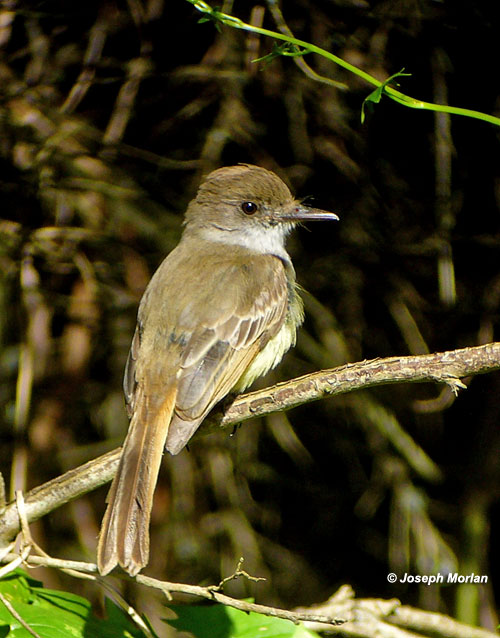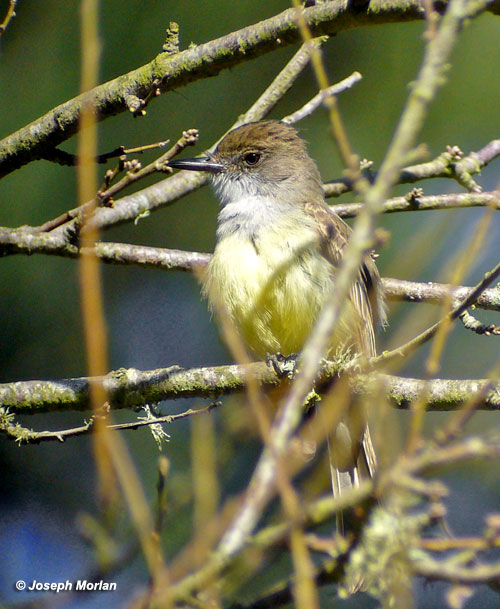Dusky-capped Flycatcher (Myiarchus tuberculifer)
Mallard Lake, Golden Gate Park, San Francisco CA
4 January 2012
Joseph Morlan
Photos © 4 January 2012 by Joseph Morlan. All rights reserved (High resolution).
 This afternoon, Robbie Fischer and I decided to head up to San Francisco
to look for the Dusky-capped Flycatcher which had been frequenting the small meadow just north of Mallard Lake
in Golden Gate Park. The bird was first found by Alan Hopkins during the San Francisco Christmas Bird Count 27
December 2011. We arrived about 1pm and walked around to the maintenance yard just northeast of the meadow. There
we encountered Richard Bradus looking for the bird. He had not seen it so we walked back to the two picnic tables
on the west side of the meadow where the sun was shining on an extensive patch of flowering German Ivy. There we
immediately saw the Dusky-capped Flycatcher foraging in a shrubby leafless tree just north of picnic table #2.
The bird was fairly jumpy, but I decided to try to digiscope it while the light was favorable with the results
here.
This afternoon, Robbie Fischer and I decided to head up to San Francisco
to look for the Dusky-capped Flycatcher which had been frequenting the small meadow just north of Mallard Lake
in Golden Gate Park. The bird was first found by Alan Hopkins during the San Francisco Christmas Bird Count 27
December 2011. We arrived about 1pm and walked around to the maintenance yard just northeast of the meadow. There
we encountered Richard Bradus looking for the bird. He had not seen it so we walked back to the two picnic tables
on the west side of the meadow where the sun was shining on an extensive patch of flowering German Ivy. There we
immediately saw the Dusky-capped Flycatcher foraging in a shrubby leafless tree just north of picnic table #2.
The bird was fairly jumpy, but I decided to try to digiscope it while the light was favorable with the results
here.
Meanwhile Robbie returned to the maintenance yard to alert Richard Bradus. They both arrived back shortly and
we spent about 45 minutes enjoying the bird as it foraged mostly in the leafless tree. First it caught a West Coast
Lady, holding its body and breaking off the wings before consuming it. Mostly it sallied after insects in the air,
but once it landed on the ground briefly to capture prey. Eventually the sun moved lower and the bird spent more
time higher in the trees, especially a tall Redwood just northeast of the picnic tables, where it was more difficult
to see.
The bird called several time while we had it under observation. 
Description
The following description is based on memory and on photos:
A small or medium-sized Myiarchus best identified by a combination of rusty edges on the top of the
tail and on its secondaries and by its distinctive vocalizations.
The head was brown with a slight crest contrasting slightly with a grayer color on the face and ear coverts
below the eye. The upperparts were brown with obvious rufous or orange color on the upper tail coverts and on the
outer edges of the base of the tail. The wings were mostly brown, but the coverts were fringed with ashy gray forming
faint wing-bars. The outer edges of the visible primaries and secondaries were basally fringed with rust or rusty-orange.
The tertials were likewise fringed with rufous except for the innermost which was edged in ashy-gray. The throat
and upper breast were grayish-white contrasting with a fairly bright yellow coloration extending from the breast
through the belly all the way to the undertail coverts. The underside of the tail was light brownish-gray with
no sign of rusty coloration.
The dark bill was quite long and relatively thin when viewed from the side. However from above or below the
bill was triangular in shape with a slight hook at the tip. The legs and feet were dark. The iris was medium brown.
This individual called fairly often, perhaps about 15 times during our observation. The most common call
was a drawn-out descending whistle but it also gave a nasal "wheeer" call somewhat recalling a call of
Spotted Towhee.
Discussion
This bird was first discovered 27 December by Alan Hopkins and it has been seen by numerous observers and well
photographed. Here are some outside links to additional photos:
This appears to be the sixth record of Dusky-capped Flycatcher for San Francisco. Prior records are Dec.-May 1989-90
at Pine Lake Park, Dec.-Jan. 1995-96 at Fort Funston; Nov.-Feb. 1996-97 at Pine Lake Park; Dec. 1997 at Lake Merced;
and Nov. 2000 at Golden Gate Park. I personally saw all of these birds.
This season there are currently at least four other Dusky-capped Flycatchers being reported in California. One
at the San Lorenzo River in Santa Cruz; one at Veteranís Park in Bell Gardens, Los Angleles County; one returning
for its fifth winter at Creek Park in La Mirada, Los Angeles County; and one at the Aviara Golf Course overlook
in Carlsbad, San Diego County. Inland, another Dusky-capped Flycatcher was seen at Shohone in Inyo County in early
November 2011. Including all these recent records brings the total number of California records to 89.
There are 13 described subspecies ranging from Arizona and Texas to Central South America. The most northerly
population M. t. olivascens is said to account for virtually all extralimital records in the United States.
Other races have a more contrasting, darker cap and some have more red in the tail.
Aging Dusky-capped Flycatchers is a challenge because they usually complete their preformative molt by mid December.
However this individual shows frayed feathers on the wing coverts and the tail which I suspect may be retained
juvenal feathers. The primary coverts also contrast with the bases of the primaries and the alula further suggesting
that this is a young bird hatched in 2011.
 This afternoon, Robbie Fischer and I decided to head up to San Francisco
to look for the Dusky-capped Flycatcher which had been frequenting the small meadow just north of Mallard Lake
in Golden Gate Park. The bird was first found by Alan Hopkins during the San Francisco Christmas Bird Count 27
December 2011. We arrived about 1pm and walked around to the maintenance yard just northeast of the meadow. There
we encountered Richard Bradus looking for the bird. He had not seen it so we walked back to the two picnic tables
on the west side of the meadow where the sun was shining on an extensive patch of flowering German Ivy. There we
immediately saw the Dusky-capped Flycatcher foraging in a shrubby leafless tree just north of picnic table #2.
The bird was fairly jumpy, but I decided to try to digiscope it while the light was favorable with the results
here.
This afternoon, Robbie Fischer and I decided to head up to San Francisco
to look for the Dusky-capped Flycatcher which had been frequenting the small meadow just north of Mallard Lake
in Golden Gate Park. The bird was first found by Alan Hopkins during the San Francisco Christmas Bird Count 27
December 2011. We arrived about 1pm and walked around to the maintenance yard just northeast of the meadow. There
we encountered Richard Bradus looking for the bird. He had not seen it so we walked back to the two picnic tables
on the west side of the meadow where the sun was shining on an extensive patch of flowering German Ivy. There we
immediately saw the Dusky-capped Flycatcher foraging in a shrubby leafless tree just north of picnic table #2.
The bird was fairly jumpy, but I decided to try to digiscope it while the light was favorable with the results
here.